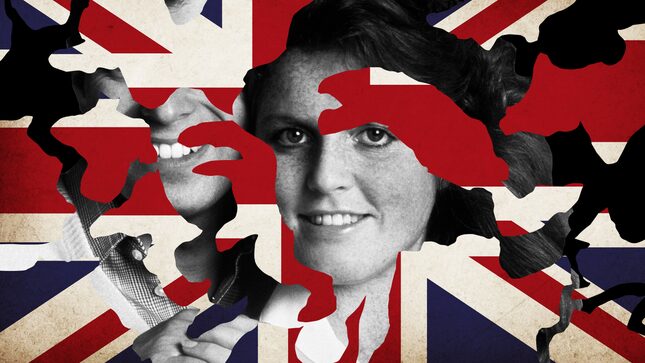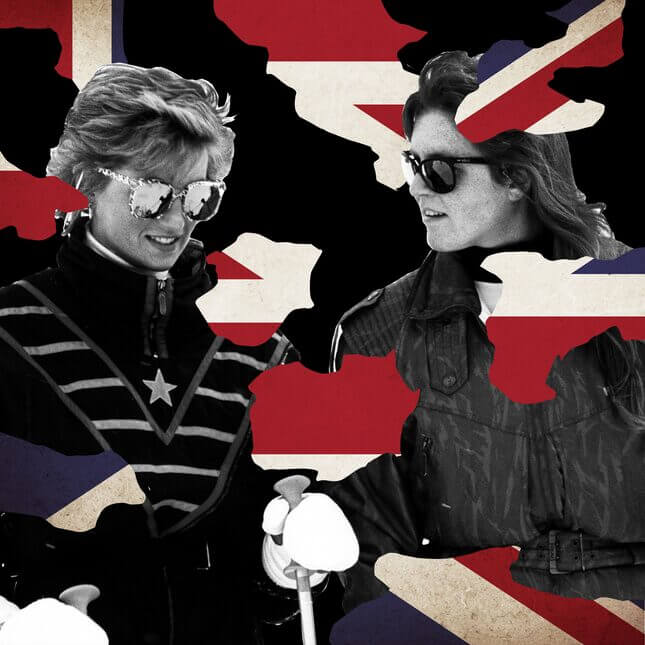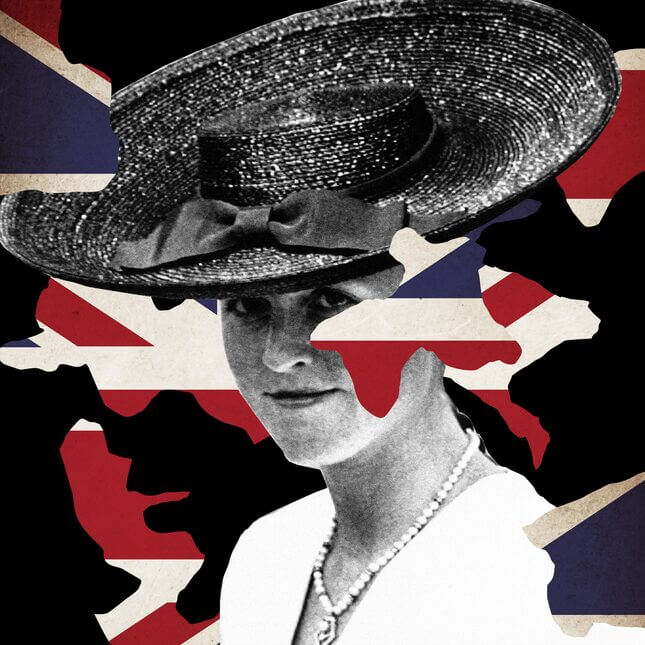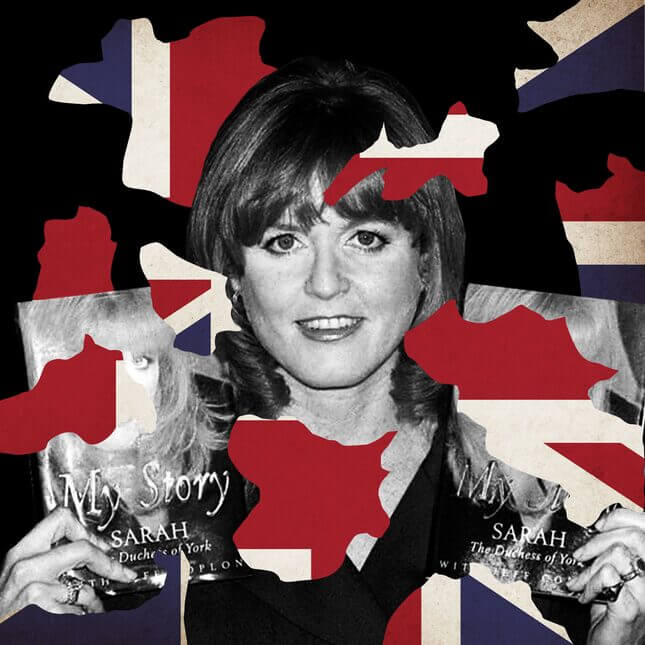The Rise and Fall and Attempted Rise Again of Sarah Ferguson, Duchess of York
In Depth
Image: Elena Scotti
Harry and Meghan and the success of The Crown have inspired a renewed level of interest in all the people who populate the archaic structure of monarchy. The Windsors’ increased profile means additional attention on a whole cast of characters who would normally slink unnoticed by all but the most obsessive royalist: This includes Sophie, Countess of Wessex, a nonentity through the 2000s to everybody but royal superfans, and Lady Amelia Windsor, “most beautiful royal” and 39th in line for the succession. But most importantly, it means the return of a character who seemed lost to the 1990s: Sarah Ferguson, Duchess of York, a.k.a. the original Fergie, a case study in the shifting narratives that form and reform around royal women.
When Sarah Ferguson first joined the long-running primetime soap opera The Windsors in the 1980s as love interest to Prince Andrew, she was a popular figure, both inside and outside of the family; for a while, she was cast in a role very close to that of Meghan Markle, as the breath of fresh air livening up the stiff royal scene. But while Markle was welcomed as a progressive figure, a woman with a thriving career and a history of philanthropy and activism, Fergie’s narrative was that she was jolly, rowdy, horsey, charming—and, thrillingly, just a bit vulgar. For instance, Vanity Fair reported that Prince Philip was “tremendously taken with her off-color after-dinner jokes.”

It didn’t help that she was paired with and compared to Diana, who was more beautiful than ever and yet increasingly publicly miserable as Fergie arrived on the scene. At first they were “The Merry Wives of Windsor,” as the media dubbed them, a couple of girls having fun together. But in 1987, Vanity Fair asked, “Is Fergie’s Fizz Leaving Di Flat?” The subhead made it even more clear that Fergie was her foil: “In the year since her wedding, the rambunctious redheaded Duchess of York has charmed the Queen, captivated Prince Philip, and romped away with the hearts of the British public. Her angst-free antics have highlighted the mounting pressures on the Princess of Wales.”
The narrative quickly turned against Ferguson. The very same qualities that had gained her praise—her cheerful informality—were deployed against her. For instance, she drew criticism for her performance in It’s a Royal Knockout, a variety show meant to demonstrate the young royals were hip and approachable, a.k.a a perfect vehicle for Ferguson. It was organized by her brother-in-law, Prince Edward, and featured several other members of the family including Anne and Andrew, but Fergie came off particularly poorly. What had once been refreshing was now recast as undignified; suddenly the vulgarity wasn’t thrilling. It’s probably not a coincidence that around the same time Fergie began to put on weight. “It became fat Fergie against wonderful Diana,” Harry Arnold of The Sun told Tina Brown.
Of course, Ferguson also landed herself in a series of embarrassing scandals, the most famous being the infamous 1992 toe-sucking photos. Already separated from Andrew, she was caught by paparazzi vacationing in France with a man named John Bryan—both topless, his mouth on her feet. (Really, it wasn’t as kinky as it sounds.) The photos were published on the front page of the Daily Mirror while Ferguson was staying at Balmoral, no less, and pretty much sealed her fate. The divorce of the Duke and Duchess of York was announced not long afterward; there would be no half in, half out role for her, and she reportedly walked away deep in debt.

As Ferguson embarked on a life outside the royal sphere, again, she was compared to Diana: “Class vs. Cash,” is how People juxtaposed them on a 1997 cover, chronicling Diana’s trip to Angola and Fergie’s release of
her memoir My Story. Even after Diana died, Ferguson was still locked into this second banana dynamic, cast as trash next to her former sister-in-law and the rest of the Windsors. Part of this was because Fergie fared much less well financially in her divorce than Diana, and if she was going to live remotely like she did while married, she needed to work.
But any money she did earn she pissed away, all while making a series of moves that came off as plainly crass. Rather than carefully, strategically building a brand, Fergie filmed jokey commercials for Ocean Spray and had a partnership with Weight Watchers, which at least enabled her to make some money from getting called “the Duchess of Pork.” For a while she was ubiquitous, making scones with Oprah and promoting Wedgwood china and Avon cosmetics.
In time, the American commercial opportunities dwindled. Building a durable media brand is much, much harder than it looks and requires immense judgement, which Ferguson unfortunately does not have. That was demonstrated by her missteps during the 2000s. She took $40,000 in cash from the tabloid News of the World’s “fake sheik” Mazher Mahmood—a man whose shtick was to pose as a wealthy Middle Eastern sheik in sting operations to get famous people to say embarrassing things on the record–to arrange a meeting with her ex; consequently, she was excluded from the wedding of the Duke and Duchess of Cambridge. She let Jeffrey Epstein pay down a debt to a former assistant. She publicly apologized, at which point Epstein reportedly considered suing her for calling him a pedophile in the apology.Fergie might have been able to claw her way back into the fold or at least parlay her association into some new opportunities. She devoted herself to charity work and generally cleaned up her act. She was invited to the Sussexes’ wedding and of course played a prominent role in the television broadcast of her daughter Eugenie’s wedding. But Andrew’s poor decisions don’t provide his ex-wife an easy road back into the public’s graces.

She’s trying, though. Even as she defends her ex in the press—in December, Vogue Arabia published an interview in which Fergie pivoted from a question on mental health to defend Andrew, insisting, “He is the best man I know. It’s just incredible what he has done for Britain, and it’s all nonsense.” She is apparently attempting to line up investors for a new lifestyle brand. The Daily Mail got hold of her pitch deck for “Duchess Inc,” a company which “hopes to combine ‘glamour’ with ‘compassion’ and includes a collection of towels, soaps and teas.” She’s proposing multiple lines, including “Fergie’s Farm,” a set of frozen meals. And also, of course, she’s planning some extremely regal jewelry:
Other items — including Tiffany-style rings and ‘Majestic’ bedlinen — are certainly aiming for the upper end of the market, and playing on her royal links.
Indeed, if you buy an item of jewellery, from £60 hooped earrings to a £110 bracelet from the Duchess Collection, you will receive a ‘free coronet pin’ badge.
Coronet pendants and bracelets are also for sale. They will be available on the shopping channel QVC.
It remains to be seen whether anybody wants to touch anything branded “Duchess” when the name of her Duke has become so deeply toxic—undermining even the camp appeal that Fergie might have.